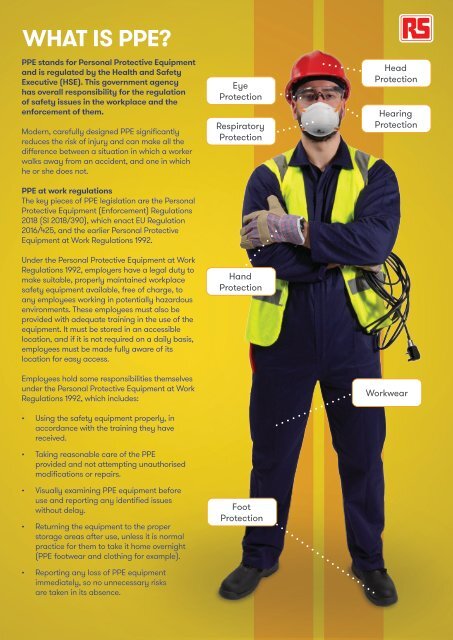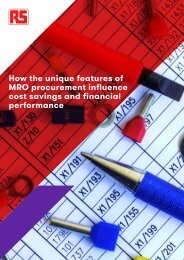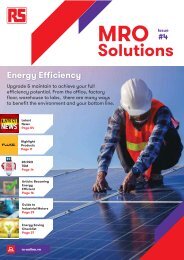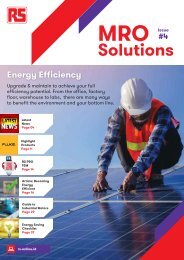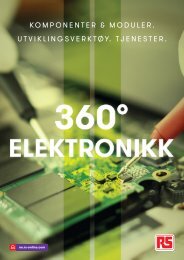PPE Brochure UK
Safety doesn't happen by accident - PPE
Safety doesn't happen by accident - PPE
You also want an ePaper? Increase the reach of your titles
YUMPU automatically turns print PDFs into web optimized ePapers that Google loves.
WHAT IS <strong>PPE</strong>?<br />
<strong>PPE</strong> stands for Personal Protective Equipment<br />
and is regulated by the Health and Safety<br />
Executive (HSE). This government agency<br />
has overall responsibility for the regulation<br />
of safety issues in the workplace and the<br />
enforcement of them.<br />
Modern, carefully designed <strong>PPE</strong> significantly<br />
reduces the risk of injury and can make all the<br />
difference between a situation in which a worker<br />
walks away from an accident, and one in which<br />
he or she does not.<br />
<strong>PPE</strong> at work regulations<br />
The key pieces of <strong>PPE</strong> legislation are the Personal<br />
Protective Equipment (Enforcement) Regulations<br />
2018 (SI 2018/390), which enact EU Regulation<br />
2016/425, and the earlier Personal Protective<br />
Equipment at Work Regulations 1992.<br />
Eye<br />
Protection<br />
Respiratory<br />
Protection<br />
Head<br />
Protection<br />
Hearing<br />
Protection<br />
HEAD<br />
PROTECTION<br />
Designed to protect the vulnerable head area from falling objects and other<br />
workplace hazards. In many work areas the provision of a hard hat is a<br />
requirement under the <strong>PPE</strong> regulations and should be enforced for worker<br />
protection. Hard hats are also frequently designed to work in conjunction<br />
with ear and eye protection as required.<br />
Under the Personal Protective Equipment at Work<br />
Regulations 1992, employers have a legal duty to<br />
make suitable, properly maintained workplace<br />
safety equipment available, free of charge, to<br />
any employees working in potentially hazardous<br />
environments. These employees must also be<br />
provided with adequate training in the use of the<br />
equipment. It must be stored in an accessible<br />
location, and if it is not required on a daily basis,<br />
employees must be made fully aware of its<br />
location for easy access.<br />
Hand<br />
Protection<br />
Leading Brands<br />
Employees hold some responsibilities themselves<br />
under the Personal Protective Equipment at Work<br />
Regulations 1992, which includes:<br />
• Using the safety equipment properly, in<br />
accordance with the training they have<br />
received.<br />
Workwear<br />
FOR A COMPLETE GUIDE<br />
TO HEAD PROTECTION<br />
Head Protection<br />
INTRODUCTION<br />
Our head protection guide will help<br />
you choose the most appropriate<br />
protective headwear for your task or<br />
environment.<br />
Hard hats are designed to protect<br />
the vulnerable head area from falling<br />
objects and other workplace hazards. In many work<br />
areas the provision of a hard hat is a requirement<br />
under the <strong>PPE</strong> regulations and should be enforced for<br />
worker protection.<br />
HARD HAT COLOUR CODING<br />
Hard hats are supplied in various colours, each often<br />
signifying the role or task of the wearer.<br />
Colours may vary from one company to another, and some<br />
organisations change colour coding every three to five<br />
years to remove any old helmets from their site.<br />
EN STANDARDS<br />
Industrial safety helmets EN 397<br />
6 HEAD PROTECTION<br />
This key standard specifies mandatory and<br />
optional physical and performance requirements<br />
(shock absorption, penetration resistance,<br />
flame resistance and chin strap attachment),<br />
including methods of test and marking<br />
• Taking reasonable care of the <strong>PPE</strong><br />
provided and not attempting unauthorised<br />
modifications or repairs.<br />
Click here<br />
WHY BUY FROM RS?<br />
As industry experts we offer a range of head protection<br />
products, from professionally approved RS branded<br />
products, to those from selected market leading brands.<br />
This means you can find all the products you need from<br />
one source, with next day delivery, competitive pricing and<br />
bulk discounts.<br />
Note: Other colours are also available in some ranges.<br />
WHEN TO USE A BUMP CAP<br />
A bump cap is designed to be used when risk to the user<br />
is from overhead stationary obstacles and not moving or<br />
falling objects when a hard hat should be worn. Compared<br />
to the hard hat, bump caps offer a lower level of head<br />
protection as defined in the standard BS EN 812:2012.<br />
Bump caps offer the following benefits to the wearer:<br />
requirements of industrial safety helmets.<br />
Helmets for mountaineers EN 12492<br />
Safety requirements and test methods.<br />
This European Standard specifies safety<br />
requirements and test methods for safety<br />
helmets for use in mountaineering. EN 12492<br />
tests include penetration resistance, shock<br />
absorption and chin strap release & strength.<br />
Electrically insulating helmets EN 50365<br />
For use on low voltage installations. Hard hats<br />
used in an area where there is risk of contact<br />
with voltages of 1,000V AC or 1,500V DC<br />
must meet this standard. Tests measure the<br />
Lightweight<br />
electrical insulation of the helmet in water.<br />
• Visually examining <strong>PPE</strong> equipment before<br />
use and reporting any identified issues<br />
without delay.<br />
• Returning the equipment to the proper<br />
storage areas after use, unless it is normal<br />
practice for them to take it home overnight<br />
(<strong>PPE</strong> footwear and clothing for example).<br />
• Reporting any loss of <strong>PPE</strong> equipment<br />
immediately, so no unnecessary risks<br />
are taken in its absence.<br />
Foot<br />
Protection<br />
Watch this video<br />
to learn about Petzl’s range of<br />
Vertex safety helmets with their<br />
6 point harness which suspends<br />
the helmet on the head ensuring<br />
balance and perfect fit<br />
Discover more at www.rs-online.com<br />
Constructed of fabric with a protective<br />
shell of HDPE or ABS, bump caps have<br />
low weight for added comfort.<br />
Washable<br />
Being made of cotton or canvas means that caps can be<br />
kept clean for repeat wear or for different personnel and<br />
visitors.<br />
Easy to wear<br />
Where there is a need to combine head protection with<br />
other <strong>PPE</strong>, such as respiratory equipment, bumps caps<br />
make this easy.<br />
High performance industrial helmets EN 14052<br />
This is a higher specification standard and<br />
helmets meeting the requirements will give the<br />
wearer additional protection for side impacts<br />
and helmet penetration.<br />
Industrial bump caps EN 812<br />
The European Standard specifying physical<br />
and performance requirements, methods of<br />
test and marking requirements for industrial<br />
bump caps. Industrial bump caps are intended<br />
to provide protection to the wearer against<br />
the effects of striking the head against hard,<br />
stationary objects.<br />
93<br />
3


